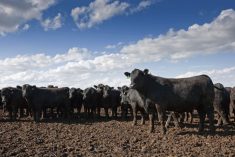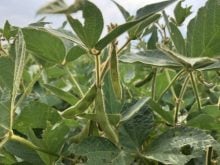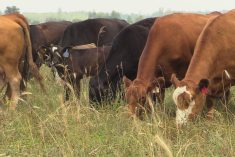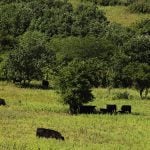Compared to last week, western Canadian yearling markets traded $4 to as much as $6 higher on average. Calf markets were sharply higher. Auction barns in Manitoba reported calf prices up $8-$10 on average with certain pockets up as much $15. Calf markets in Alberta and Saskatchewan were up a solid $5-$8 from week-ago levels.
Sometimes, markets can be hard to explain and one week can make a world of difference. August and September feeder cattle futures surged over $5 on Monday and this set the tone for the week. Finishing feedlots were aggressive buyers on all weight categories for nearby and deferred positions. Demand from Ontario led the charge higher in Manitoba and this buying interest appeared to stretch farther west. By Wednesday, the Alberta fed cattle market was quoted on a dressed basis in the range of $280-$282. This equates to about $180 on a live basis which is a fresh 52-week high. For December delivery, basis levels have been firm allowing feedlot operators to lock in a fed cattle price from $188 to $190. Margins are moving just above break-even in the deferred positions which is setting the tone for nearby feeder cattle.
Read Also

U.S. grains: Soybeans rise on China demand hopes; corn and wheat rebound
Chicago Board of Trade soybean, corn and wheat futures rose on Monday on signs of progress towards the end of a record-long U.S. government shutdown, along with expectations of a revival of U.S. soybean exports to China, analysts said.
In central Alberta, mixed red steers with medium flesh averaging 875 lbs. on small grain ration with full health records dropped the gavel at $192; their younger brothers with same specifications weighing 815 lbs. were quoted at $206. South of Edmonton, red mixed heifers with medium to lower flesh coming with health data and weighing 860 lbs. were reported at $182. Southeast of Calgary, Angus-blended heifers with light butter weighing 830 lbs. were valued at $186.
In the Lethbridge area, larger-frame tan steers with medium flesh coming off small grain ration weighing just over 800 lbs. were valued at $208 landed in the feedlot. In central Saskatchewan, Simmental-blended steers weighing 830 lbs. with medium to thicker butter were valued at $195. Yearling supplies were limited in Manitoba this week.
In central Alberta, Simmental mixed steers with full health records on mostly silage ration averaging 615 lbs. were quoted at $230 and mixed heifers weighing 540 lbs. on mostly forage diet were reported at $194. Southeast of Saskatoon, larger-frame mixed steers averaging just over 700 lbs. reached up to $220. Northwest of Winnipeg, a small group of black steers weighing 530 lbs. sold for $257 and similar-quality heifers weighing 580 lbs. dropped the gavel at $202. Black steers weighing just over 600 lbs. were valued at $240.
In a normal year, corn and barley prices tend to trend lower once farmers have finished seeding. This causes the feeder market to experience a seasonal rally from mid-May through July. The feeder market is factoring in average yields for the upcoming barley and corn crops. This makes the feeder market somewhat vulnerable if adverse growing conditions materialize. However, in the short term, the seasonal upward trend probably has some breathing room.
— Jerry Klassen is president and founder of Resilient Capital, specializing in proprietary commodity futures trading and market analysis. Jerry consults with feedlots on risk management and writes a weekly cattle market commentary. He can be reached at 204-504-8339 or via his website at ResilCapital.com.















